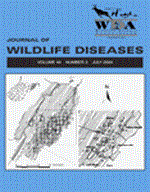Avian vacuolar myelinopathy (AVM) was first recognized as a cause of bald eagle (Haliaeetus leucocephalus) mortality in 1994 in Arkansas (USA) and has since caused over 90 bald eagle and numerous American coot (Fulica americana) mortalities in five southeastern states. The cause of AVM remains undetermined but is suspected to be a biotoxin. Naturally occurring AVM has been limited to wild waterbirds, raptors, and one species of shorebird, and has been reproduced experimentally in red-tailed hawks (Buteo jamaicensis). In this study, chickens and swine were evaluated for susceptibility to vacuolar myelinopathy with the intent of developing animal models for research and to identify specific tissues in affected coots that contain the causative agent. Additionally, submerged, aquatic vegetation, primarily hydrilla (Hydrilla verticillata), and associated material collected from a reservoir during an AVM outbreak was fed to chickens in an effort to reproduce the disease. In two separate experiments, six 4-wk-old leghorn chickens and ten 5-wk-old leghorn chickens were fed coot tissues. In a third experiment, five 3-mo-old domestic swine and one red-tailed hawk, serving as a positive control, were fed coot tissues. In these experiments, treatment animals received tissues (brain, fat, intestinal tract, kidney, liver, and/or muscle) from coots with AVM lesions collected at a lake during an AVM outbreak. Negative control chickens and one pig received tissues from coots without AVM lesions that had been collected at a lake where AVM has never been documented. In a fourth experiment, eight 3-wk-old leghorn chickens were fed aquatic vegetation material. Four chickens received material from the same lake from which coots with AVM lesions were collected for the previous experiments, and four control chickens were fed material from the lake where AVM has never been documented. Blood was collected and physical and neurologic exams were conducted on animals before and once per week during the trials. All animals were sacrificed and necropsies were performed on Day 29 of feeding, with the exception of one treated chicken that was sacrificed and necropsied on Day 15 of feeding. Microscopic lesions of vacuolar myelinopathy were present in the red-tailed hawk and five chickens that received a mixture of all tissues and two chickens that received only gastrointestinal tissues of coots with AVM lesions. Three of four treated chickens in the aquatic vegetation trial developed vacuolar lesions. None of four treatment pigs or any of the negative control animals developed vacuolar lesions. Chickens are susceptible to AVM and may serve as a useful animal model for future studies. Swine may be refractory to AVM or not affected by AVM at the same dose as are chickens and red-tailed hawks. The causative agent of AVM in affected coots is associated with the gastrointestinal tissues. Furthermore, AVM can be reproduced in chickens via ingestion of aquatic vegetation and associated materials collected from a lake during an AVM outbreak. The cause of AVM is most likely present in the materials associated with submerged vegetation because the vegetation itself (hydrilla) was the same at our AVM-positive and AVM-negative sites.
How to translate text using browser tools
1 July 2004
ATTEMPTS TO REPRODUCE VACUOLAR MYELINOPATHY IN DOMESTIC SWINE AND CHICKENS
Lynn A. Lewis-Weis,
Richard W. Gerhold,
John R. Fischer

Journal of Wildlife Diseases
Vol. 40 • No. 3
July 2004
Vol. 40 • No. 3
July 2004
American Coot
avian vacuolar myelinopathy
Bald Eagle
chicken
Hydrilla
intramyelinic edema
neurologic disease




